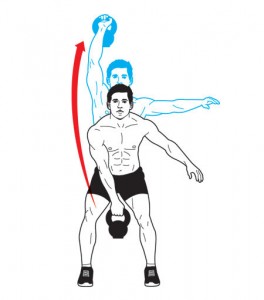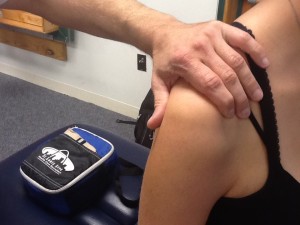In the past, I wrote a post about Crossfit and shoulder pain based on a 38 y/o male client of mine. Click here to read that post. In my prior entry, I discussed differential diagnosis of rotator cuff and labral pathology, as well as my treatment approach for that client.
If you follow my blog, twitter feed or webinars, you know I treat a lot of Crossfit athletes. Recently, I worked with a 25 y/o female suffering from marked shoulder pain that was keeping her out of the gym.

Below are the key findings from her intake on 8/30/13:
- Onset of left shoulder pain on 8/8 related to snatches
- Right hand dominant
- Intermittent pain if sleeping on her left side
- Full AROM
- Mild weakness with supraspinatus and external rotation on left
- Positive impingement signs
- Positive O’Brien’s test (labral test)
- Positive sulcus sign bilaterally (indicates multi-directional instability or MDI)

Sulcus sign
Treatment intervention
- Rhythmic stabilization and PNF exercises
- Rotator cuff and scapular strengthening
- Closed chain stabilization training
- Game Ready (cryotherapy)
- Home program issued at visit #1
I saw the patient once per week and she did her home program for 4 weeks. At week 4, we gradually began allowing her to do some modified gym workouts but still no snatches or full overhead work. She was pain free at this time and all impingement/labral signs had resolved. At this point she returned to some wall ball drills (limited height) but still no snatches.
The client’s final visit was on 10/2/13. Her Quick Dash percentage of perceived shoulder dysfunction was now 0%. She was symptom free, but more importantly she had a great understanding of how to modify her lifts, loads and volume based on her multi-directional instability. She was now aware of how her instability impacts her shoulder in “at risk” positions and in the face of fatigue. This brings me to the primary reason for this second post related to Crossfit and shoulder pain.
In my initial post, I focused on overuse and shoulder inflammation as a result of poor mobility, muscle imbalances and a lack of physical preparedness to do high intensity exercise like Crossfit. On the other end of the spectrum lies the unstable shoulder.
Hypermobility and/or shoulder instability is a major problem for those doing Crossfit in light of the following:
- Many lifts and exercises put the shoulder in “at risk” positions
- Poor glenohumeral joint stability places more stress on the rotator cuff and long head of the biceps
- With the AMRAP approach and train to failure nature of the WOD, fatigue is a given and this means the stabilizing muscles that matter most will often fail leading to a much higher injury risk
Key Takeaways
- My client had secondary rotator cuff and bicipital irritation related to primary instability
- Rest and a combined stabilization and cuff/scapular strengthening exercise program was effective in resolving her symptoms within 30 days
- High load/high volume overhead lifts and those that place the shoulder at end range pose a higher injury risk for those with MDI or anterior instability
- Shoulder stability work trumps mobility work in those with shoulder instability - this often runs counter to traditional approaches that tend emphasize better mobility (one program does not fit all)
Closing thoughts
We must keep in mind that the shoulder is inherently unstable in order to allow us the freedom of movement necessary to perform the various tasks and exercise. With that said, repetitive movements and lifts can create micro and/or frank shoulder instability over time. Those with a history of shoulder subluxation/dislocation/instability are a high risk group to begin with. Adding high loads to failure places the shoulder in a fatigue and compromising state. As a coach, competitor or health professional, we must remember that even the best intentions and coaching can fail us if the risk of a lift outweighs the reward.
As I have said before, anyone who decides to do Crossfit MUST get a proper assessment prior to starting to reduce injury risk. Ideally, this assessment would begin with a full FMS to help uncover any mobility or stability issues and asymmetry. Keep in mind research reveals that females will almost always score a 3 on shoulder mobility and many may be hypermobile. Conversely, they tend to score lower (1 in many cases) on the trunk stability push-up. Any pain with screening would necessitate a referral to a PT or MD for further evaluation.
Trainers cannot be asked or expected to catch multi-directional shoulder instability. However, they can and should be aware of relative risk, anatomical tendencies and red flags that may predispose clients to injury. For those wanting to be the best in the business, I would suggest developing a system for assessing clients and partnering with allied health professionals like me to incorporate best practices in their business. Perhaps most importantly, trainers and coaches must be willing to adapt, limit, or eliminate exercise that does not fit the needs and abilities of the clientele.
The random nature of the WOD makes it difficult for unassuming clients to judge how best to fit in the Crossfit model if they have a dysfunction or injury concern. My goal is always to empower people with knowledge about their body and sound advice for optimal training. For those intent upon getting back to Crossfit after injury, I work hard to normalize their function and offer tweaks and modifications to prevent re-injury. Prehab is a must for this population. But in the end, some shoulders will simply not be able to handle the rigors and intensity of Crossfit.
Комментариев нет:
Отправить комментарий